PROJ6006: Organisational Behaviour & Leadership in Project Teams
VerifiedAdded on 2023/01/18
|11
|2726
|52
Case Study
AI Summary
This case study analyzes the leadership approaches suitable for managing project teams within Ecological Wastewater Solutions Pty Ltd (EWS), a company expanding into new markets. It advocates for a visionary leadership style to create a shared vision among team members and suggests utilizing project management tools and techniques like agile methodology to support organizational goals. The report identifies expert, charismatic, moral, reward, and referent power as key motivators for employees and emphasizes the importance of developing self-managed teams for enhanced productivity. Furthermore, it outlines steps project managers can take to address potential challenges, including delegating tasks based on skill levels, fostering a positive work environment, promoting team building, strategic planning, using centralized project management software, and ensuring effective information flow among team members. The case study concludes that visionary leadership is the best approach for EWS, as it fosters a shared vision and motivates the workforce.
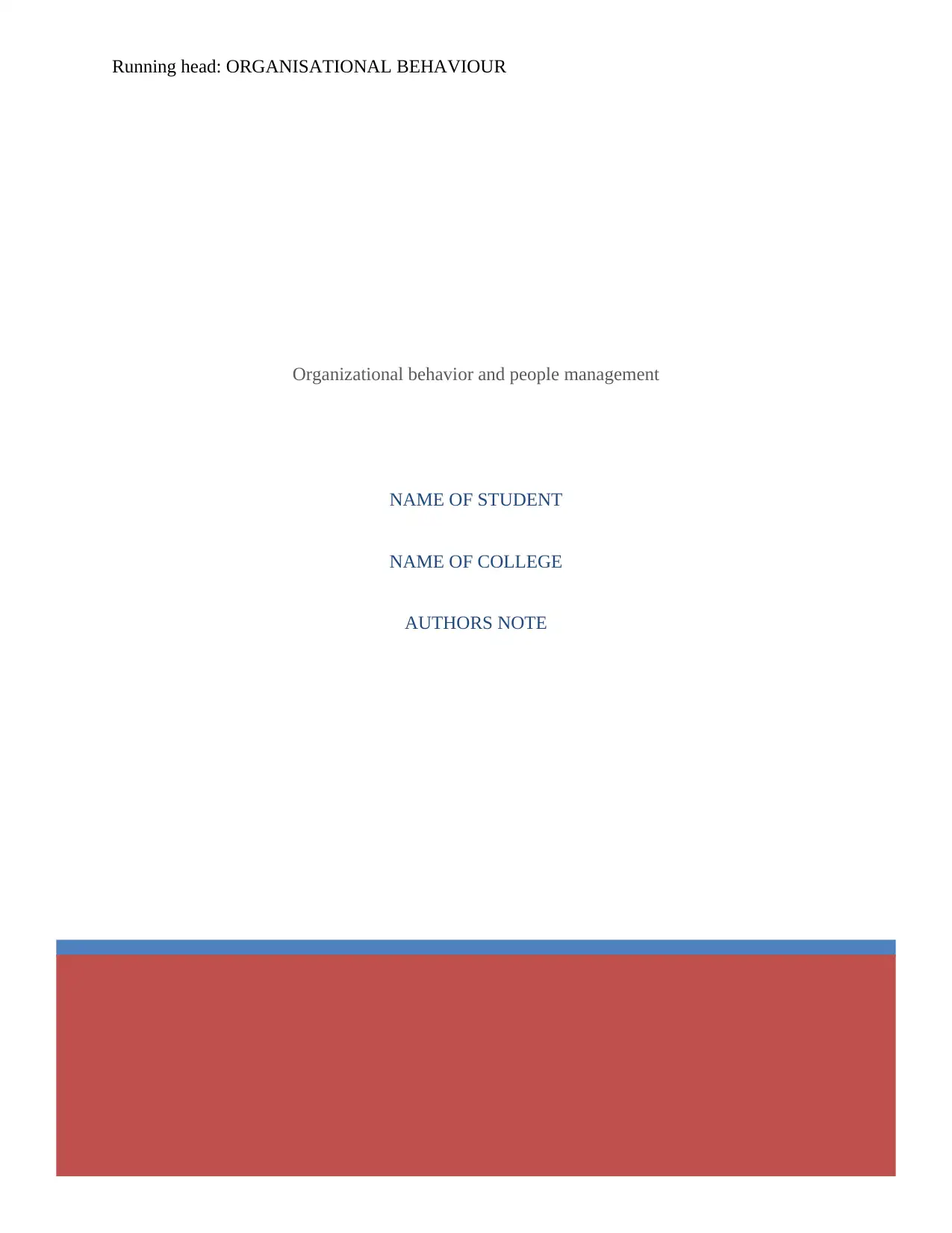
Organizational behavior and people management
NAME OF STUDENT
NAME OF COLLEGE
AUTHORS NOTE
Running head: ORGANISATIONAL BEHAVIOUR
NAME OF STUDENT
NAME OF COLLEGE
AUTHORS NOTE
Running head: ORGANISATIONAL BEHAVIOUR
Paraphrase This Document
Need a fresh take? Get an instant paraphrase of this document with our AI Paraphraser
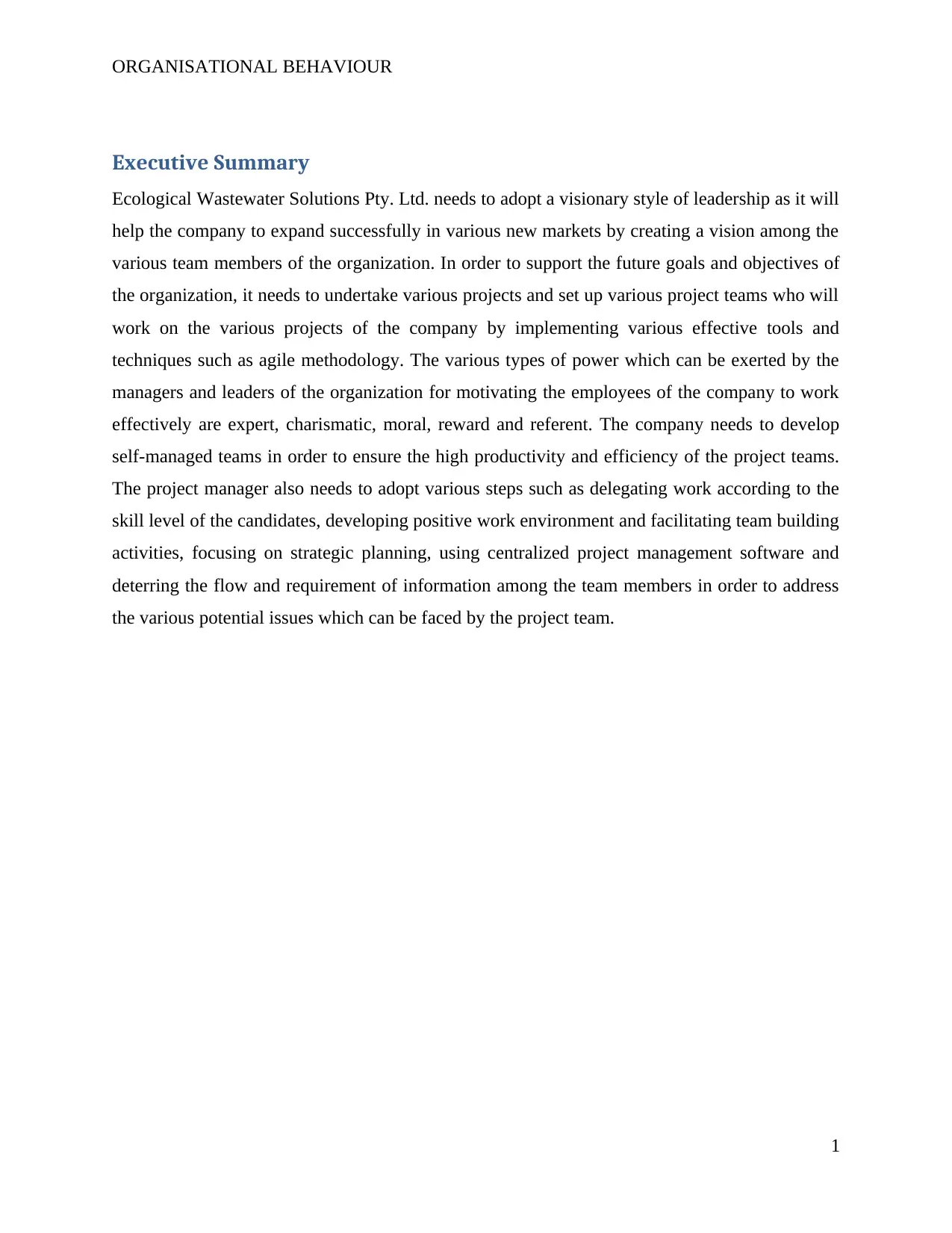
ORGANISATIONAL BEHAVIOUR
Executive Summary
Ecological Wastewater Solutions Pty. Ltd. needs to adopt a visionary style of leadership as it will
help the company to expand successfully in various new markets by creating a vision among the
various team members of the organization. In order to support the future goals and objectives of
the organization, it needs to undertake various projects and set up various project teams who will
work on the various projects of the company by implementing various effective tools and
techniques such as agile methodology. The various types of power which can be exerted by the
managers and leaders of the organization for motivating the employees of the company to work
effectively are expert, charismatic, moral, reward and referent. The company needs to develop
self-managed teams in order to ensure the high productivity and efficiency of the project teams.
The project manager also needs to adopt various steps such as delegating work according to the
skill level of the candidates, developing positive work environment and facilitating team building
activities, focusing on strategic planning, using centralized project management software and
deterring the flow and requirement of information among the team members in order to address
the various potential issues which can be faced by the project team.
1
Executive Summary
Ecological Wastewater Solutions Pty. Ltd. needs to adopt a visionary style of leadership as it will
help the company to expand successfully in various new markets by creating a vision among the
various team members of the organization. In order to support the future goals and objectives of
the organization, it needs to undertake various projects and set up various project teams who will
work on the various projects of the company by implementing various effective tools and
techniques such as agile methodology. The various types of power which can be exerted by the
managers and leaders of the organization for motivating the employees of the company to work
effectively are expert, charismatic, moral, reward and referent. The company needs to develop
self-managed teams in order to ensure the high productivity and efficiency of the project teams.
The project manager also needs to adopt various steps such as delegating work according to the
skill level of the candidates, developing positive work environment and facilitating team building
activities, focusing on strategic planning, using centralized project management software and
deterring the flow and requirement of information among the team members in order to address
the various potential issues which can be faced by the project team.
1
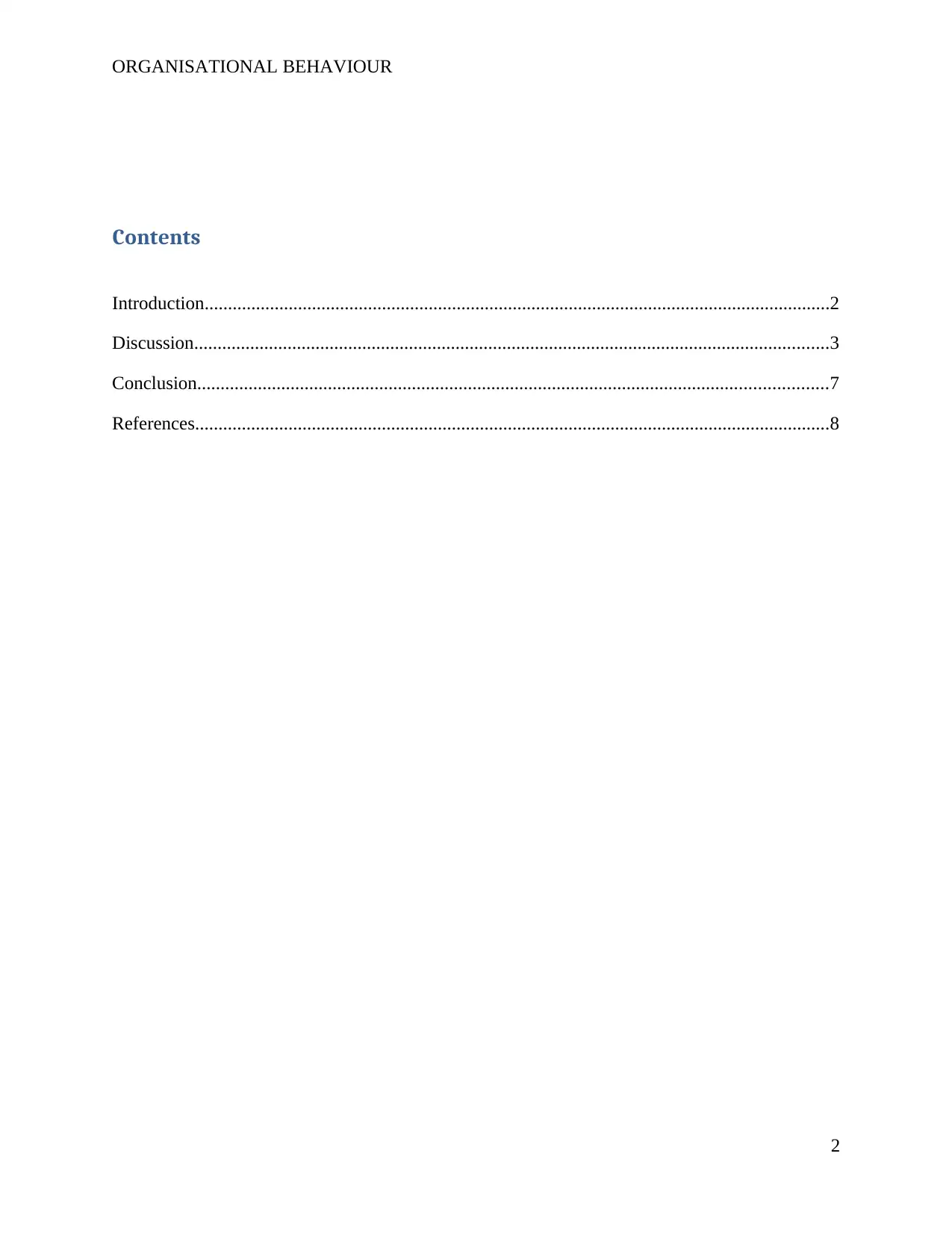
ORGANISATIONAL BEHAVIOUR
Contents
Introduction......................................................................................................................................2
Discussion........................................................................................................................................3
Conclusion.......................................................................................................................................7
References........................................................................................................................................8
2
Contents
Introduction......................................................................................................................................2
Discussion........................................................................................................................................3
Conclusion.......................................................................................................................................7
References........................................................................................................................................8
2
⊘ This is a preview!⊘
Do you want full access?
Subscribe today to unlock all pages.

Trusted by 1+ million students worldwide
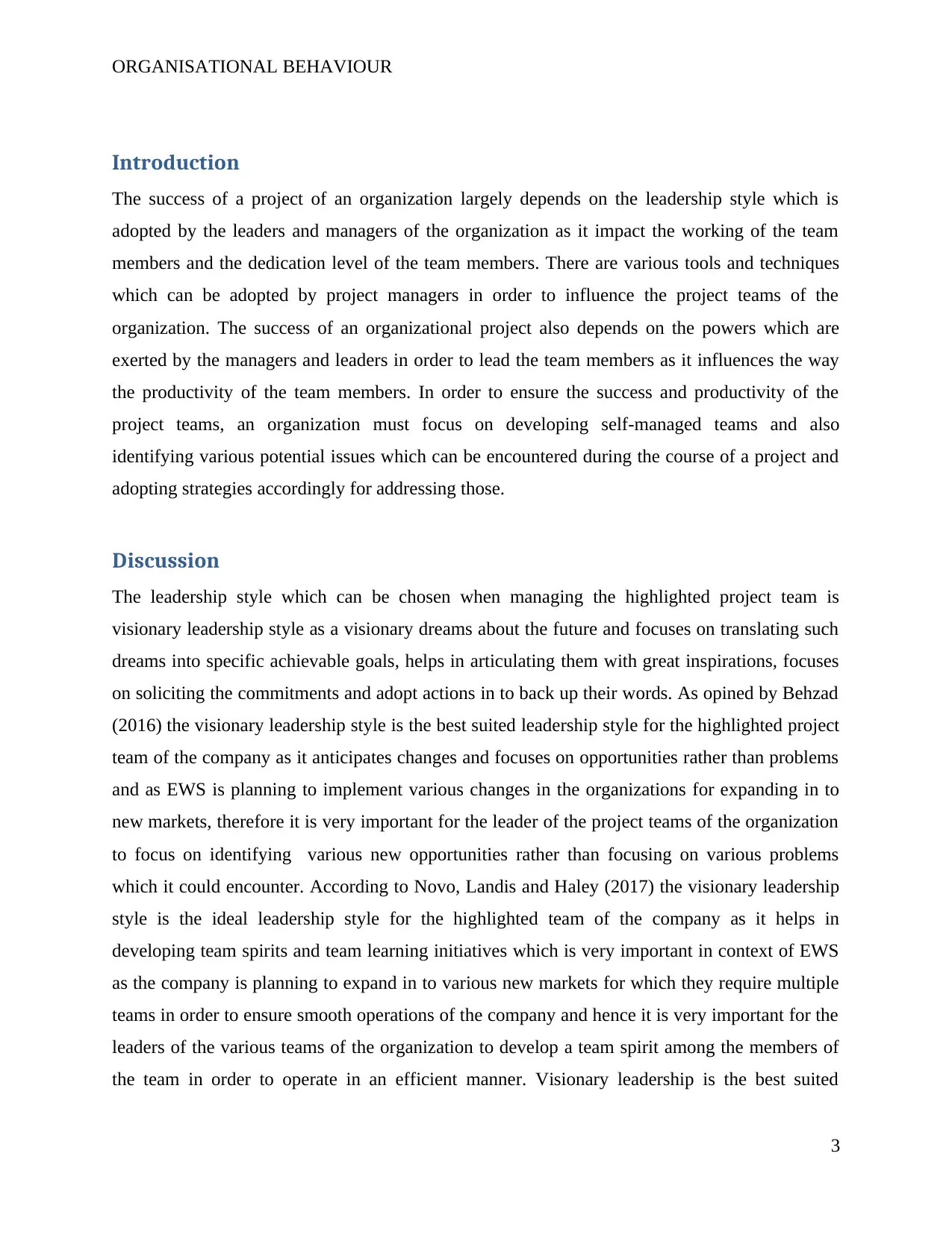
ORGANISATIONAL BEHAVIOUR
Introduction
The success of a project of an organization largely depends on the leadership style which is
adopted by the leaders and managers of the organization as it impact the working of the team
members and the dedication level of the team members. There are various tools and techniques
which can be adopted by project managers in order to influence the project teams of the
organization. The success of an organizational project also depends on the powers which are
exerted by the managers and leaders in order to lead the team members as it influences the way
the productivity of the team members. In order to ensure the success and productivity of the
project teams, an organization must focus on developing self-managed teams and also
identifying various potential issues which can be encountered during the course of a project and
adopting strategies accordingly for addressing those.
Discussion
The leadership style which can be chosen when managing the highlighted project team is
visionary leadership style as a visionary dreams about the future and focuses on translating such
dreams into specific achievable goals, helps in articulating them with great inspirations, focuses
on soliciting the commitments and adopt actions in to back up their words. As opined by Behzad
(2016) the visionary leadership style is the best suited leadership style for the highlighted project
team of the company as it anticipates changes and focuses on opportunities rather than problems
and as EWS is planning to implement various changes in the organizations for expanding in to
new markets, therefore it is very important for the leader of the project teams of the organization
to focus on identifying various new opportunities rather than focusing on various problems
which it could encounter. According to Novo, Landis and Haley (2017) the visionary leadership
style is the ideal leadership style for the highlighted team of the company as it helps in
developing team spirits and team learning initiatives which is very important in context of EWS
as the company is planning to expand in to various new markets for which they require multiple
teams in order to ensure smooth operations of the company and hence it is very important for the
leaders of the various teams of the organization to develop a team spirit among the members of
the team in order to operate in an efficient manner. Visionary leadership is the best suited
3
Introduction
The success of a project of an organization largely depends on the leadership style which is
adopted by the leaders and managers of the organization as it impact the working of the team
members and the dedication level of the team members. There are various tools and techniques
which can be adopted by project managers in order to influence the project teams of the
organization. The success of an organizational project also depends on the powers which are
exerted by the managers and leaders in order to lead the team members as it influences the way
the productivity of the team members. In order to ensure the success and productivity of the
project teams, an organization must focus on developing self-managed teams and also
identifying various potential issues which can be encountered during the course of a project and
adopting strategies accordingly for addressing those.
Discussion
The leadership style which can be chosen when managing the highlighted project team is
visionary leadership style as a visionary dreams about the future and focuses on translating such
dreams into specific achievable goals, helps in articulating them with great inspirations, focuses
on soliciting the commitments and adopt actions in to back up their words. As opined by Behzad
(2016) the visionary leadership style is the best suited leadership style for the highlighted project
team of the company as it anticipates changes and focuses on opportunities rather than problems
and as EWS is planning to implement various changes in the organizations for expanding in to
new markets, therefore it is very important for the leader of the project teams of the organization
to focus on identifying various new opportunities rather than focusing on various problems
which it could encounter. According to Novo, Landis and Haley (2017) the visionary leadership
style is the ideal leadership style for the highlighted team of the company as it helps in
developing team spirits and team learning initiatives which is very important in context of EWS
as the company is planning to expand in to various new markets for which they require multiple
teams in order to ensure smooth operations of the company and hence it is very important for the
leaders of the various teams of the organization to develop a team spirit among the members of
the team in order to operate in an efficient manner. Visionary leadership is the best suited
3
Paraphrase This Document
Need a fresh take? Get an instant paraphrase of this document with our AI Paraphraser
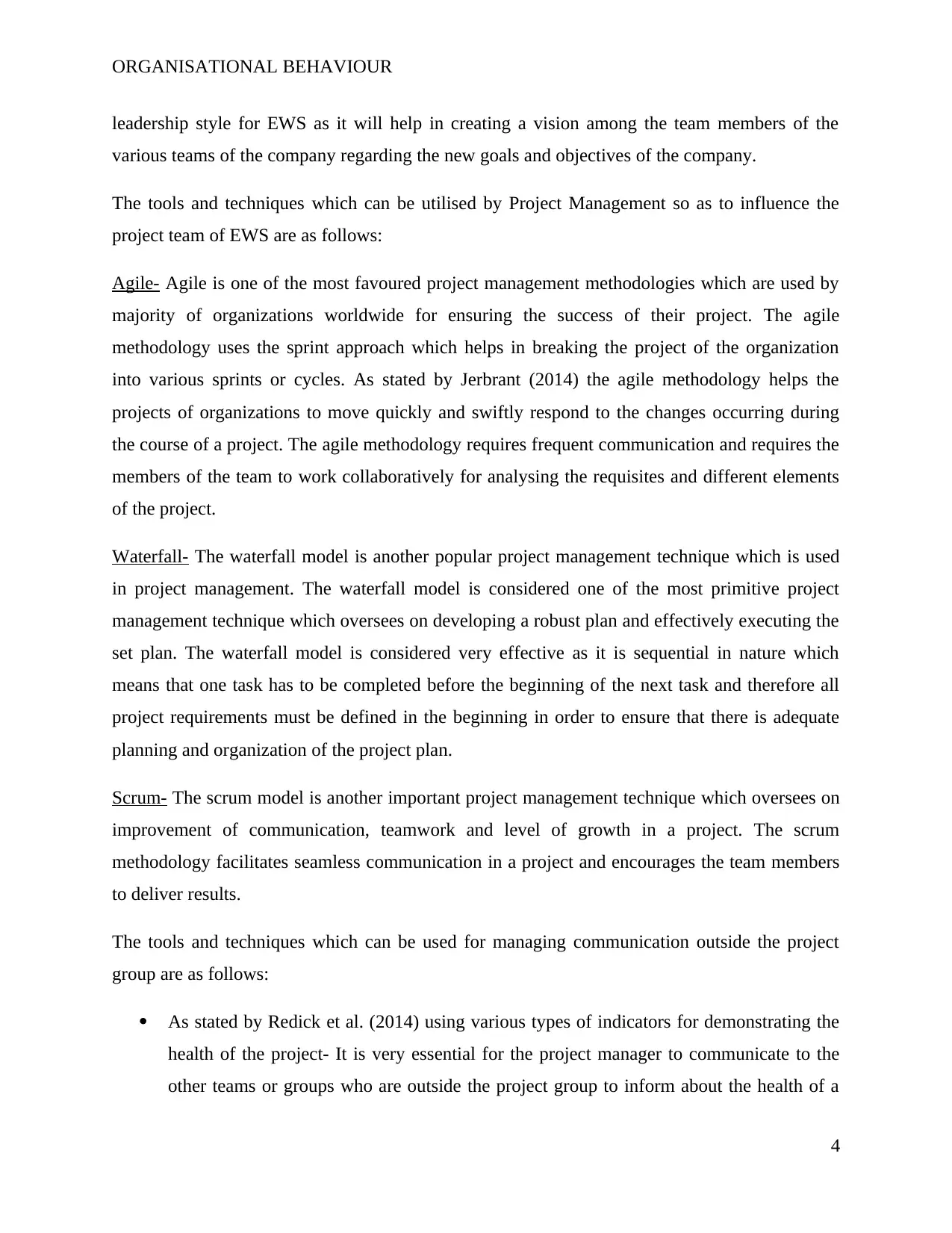
ORGANISATIONAL BEHAVIOUR
leadership style for EWS as it will help in creating a vision among the team members of the
various teams of the company regarding the new goals and objectives of the company.
The tools and techniques which can be utilised by Project Management so as to influence the
project team of EWS are as follows:
Agile- Agile is one of the most favoured project management methodologies which are used by
majority of organizations worldwide for ensuring the success of their project. The agile
methodology uses the sprint approach which helps in breaking the project of the organization
into various sprints or cycles. As stated by Jerbrant (2014) the agile methodology helps the
projects of organizations to move quickly and swiftly respond to the changes occurring during
the course of a project. The agile methodology requires frequent communication and requires the
members of the team to work collaboratively for analysing the requisites and different elements
of the project.
Waterfall- The waterfall model is another popular project management technique which is used
in project management. The waterfall model is considered one of the most primitive project
management technique which oversees on developing a robust plan and effectively executing the
set plan. The waterfall model is considered very effective as it is sequential in nature which
means that one task has to be completed before the beginning of the next task and therefore all
project requirements must be defined in the beginning in order to ensure that there is adequate
planning and organization of the project plan.
Scrum- The scrum model is another important project management technique which oversees on
improvement of communication, teamwork and level of growth in a project. The scrum
methodology facilitates seamless communication in a project and encourages the team members
to deliver results.
The tools and techniques which can be used for managing communication outside the project
group are as follows:
As stated by Redick et al. (2014) using various types of indicators for demonstrating the
health of the project- It is very essential for the project manager to communicate to the
other teams or groups who are outside the project group to inform about the health of a
4
leadership style for EWS as it will help in creating a vision among the team members of the
various teams of the company regarding the new goals and objectives of the company.
The tools and techniques which can be utilised by Project Management so as to influence the
project team of EWS are as follows:
Agile- Agile is one of the most favoured project management methodologies which are used by
majority of organizations worldwide for ensuring the success of their project. The agile
methodology uses the sprint approach which helps in breaking the project of the organization
into various sprints or cycles. As stated by Jerbrant (2014) the agile methodology helps the
projects of organizations to move quickly and swiftly respond to the changes occurring during
the course of a project. The agile methodology requires frequent communication and requires the
members of the team to work collaboratively for analysing the requisites and different elements
of the project.
Waterfall- The waterfall model is another popular project management technique which is used
in project management. The waterfall model is considered one of the most primitive project
management technique which oversees on developing a robust plan and effectively executing the
set plan. The waterfall model is considered very effective as it is sequential in nature which
means that one task has to be completed before the beginning of the next task and therefore all
project requirements must be defined in the beginning in order to ensure that there is adequate
planning and organization of the project plan.
Scrum- The scrum model is another important project management technique which oversees on
improvement of communication, teamwork and level of growth in a project. The scrum
methodology facilitates seamless communication in a project and encourages the team members
to deliver results.
The tools and techniques which can be used for managing communication outside the project
group are as follows:
As stated by Redick et al. (2014) using various types of indicators for demonstrating the
health of the project- It is very essential for the project manager to communicate to the
other teams or groups who are outside the project group to inform about the health of a
4
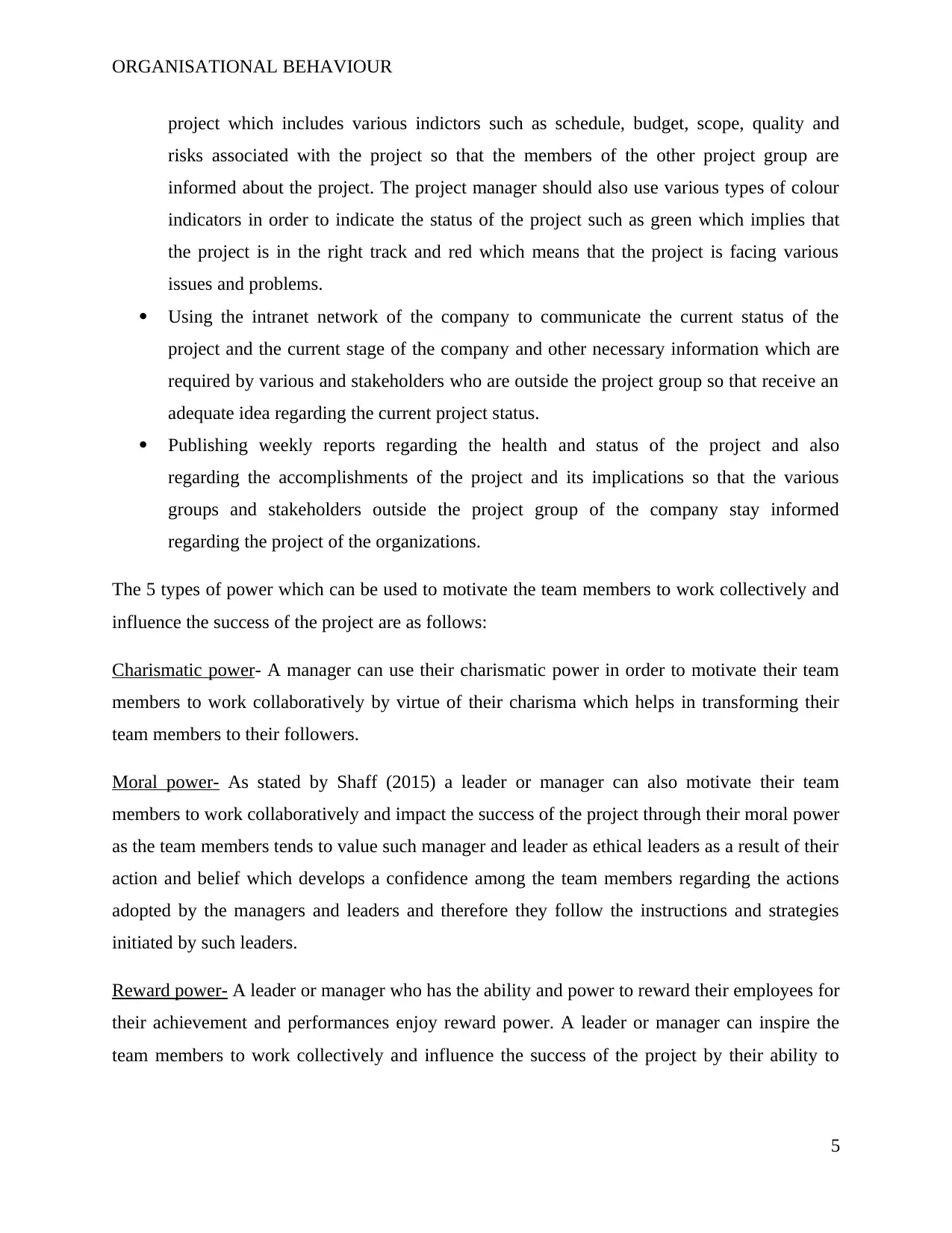
ORGANISATIONAL BEHAVIOUR
project which includes various indictors such as schedule, budget, scope, quality and
risks associated with the project so that the members of the other project group are
informed about the project. The project manager should also use various types of colour
indicators in order to indicate the status of the project such as green which implies that
the project is in the right track and red which means that the project is facing various
issues and problems.
Using the intranet network of the company to communicate the current status of the
project and the current stage of the company and other necessary information which are
required by various and stakeholders who are outside the project group so that receive an
adequate idea regarding the current project status.
Publishing weekly reports regarding the health and status of the project and also
regarding the accomplishments of the project and its implications so that the various
groups and stakeholders outside the project group of the company stay informed
regarding the project of the organizations.
The 5 types of power which can be used to motivate the team members to work collectively and
influence the success of the project are as follows:
Charismatic power- A manager can use their charismatic power in order to motivate their team
members to work collaboratively by virtue of their charisma which helps in transforming their
team members to their followers.
Moral power- As stated by Shaff (2015) a leader or manager can also motivate their team
members to work collaboratively and impact the success of the project through their moral power
as the team members tends to value such manager and leader as ethical leaders as a result of their
action and belief which develops a confidence among the team members regarding the actions
adopted by the managers and leaders and therefore they follow the instructions and strategies
initiated by such leaders.
Reward power- A leader or manager who has the ability and power to reward their employees for
their achievement and performances enjoy reward power. A leader or manager can inspire the
team members to work collectively and influence the success of the project by their ability to
5
project which includes various indictors such as schedule, budget, scope, quality and
risks associated with the project so that the members of the other project group are
informed about the project. The project manager should also use various types of colour
indicators in order to indicate the status of the project such as green which implies that
the project is in the right track and red which means that the project is facing various
issues and problems.
Using the intranet network of the company to communicate the current status of the
project and the current stage of the company and other necessary information which are
required by various and stakeholders who are outside the project group so that receive an
adequate idea regarding the current project status.
Publishing weekly reports regarding the health and status of the project and also
regarding the accomplishments of the project and its implications so that the various
groups and stakeholders outside the project group of the company stay informed
regarding the project of the organizations.
The 5 types of power which can be used to motivate the team members to work collectively and
influence the success of the project are as follows:
Charismatic power- A manager can use their charismatic power in order to motivate their team
members to work collaboratively by virtue of their charisma which helps in transforming their
team members to their followers.
Moral power- As stated by Shaff (2015) a leader or manager can also motivate their team
members to work collaboratively and impact the success of the project through their moral power
as the team members tends to value such manager and leader as ethical leaders as a result of their
action and belief which develops a confidence among the team members regarding the actions
adopted by the managers and leaders and therefore they follow the instructions and strategies
initiated by such leaders.
Reward power- A leader or manager who has the ability and power to reward their employees for
their achievement and performances enjoy reward power. A leader or manager can inspire the
team members to work collectively and influence the success of the project by their ability to
5
⊘ This is a preview!⊘
Do you want full access?
Subscribe today to unlock all pages.

Trusted by 1+ million students worldwide
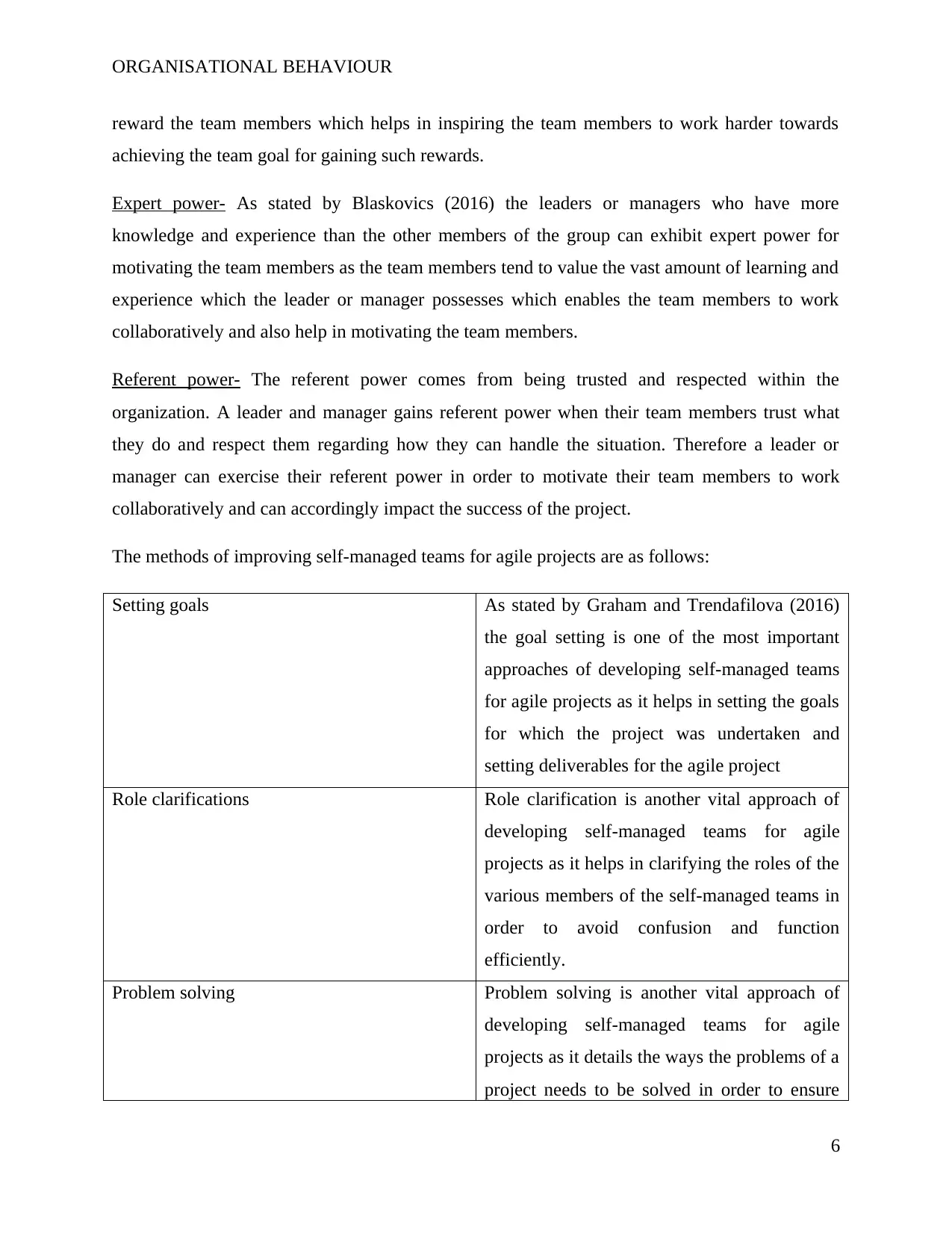
ORGANISATIONAL BEHAVIOUR
reward the team members which helps in inspiring the team members to work harder towards
achieving the team goal for gaining such rewards.
Expert power- As stated by Blaskovics (2016) the leaders or managers who have more
knowledge and experience than the other members of the group can exhibit expert power for
motivating the team members as the team members tend to value the vast amount of learning and
experience which the leader or manager possesses which enables the team members to work
collaboratively and also help in motivating the team members.
Referent power- The referent power comes from being trusted and respected within the
organization. A leader and manager gains referent power when their team members trust what
they do and respect them regarding how they can handle the situation. Therefore a leader or
manager can exercise their referent power in order to motivate their team members to work
collaboratively and can accordingly impact the success of the project.
The methods of improving self-managed teams for agile projects are as follows:
Setting goals As stated by Graham and Trendafilova (2016)
the goal setting is one of the most important
approaches of developing self-managed teams
for agile projects as it helps in setting the goals
for which the project was undertaken and
setting deliverables for the agile project
Role clarifications Role clarification is another vital approach of
developing self-managed teams for agile
projects as it helps in clarifying the roles of the
various members of the self-managed teams in
order to avoid confusion and function
efficiently.
Problem solving Problem solving is another vital approach of
developing self-managed teams for agile
projects as it details the ways the problems of a
project needs to be solved in order to ensure
6
reward the team members which helps in inspiring the team members to work harder towards
achieving the team goal for gaining such rewards.
Expert power- As stated by Blaskovics (2016) the leaders or managers who have more
knowledge and experience than the other members of the group can exhibit expert power for
motivating the team members as the team members tend to value the vast amount of learning and
experience which the leader or manager possesses which enables the team members to work
collaboratively and also help in motivating the team members.
Referent power- The referent power comes from being trusted and respected within the
organization. A leader and manager gains referent power when their team members trust what
they do and respect them regarding how they can handle the situation. Therefore a leader or
manager can exercise their referent power in order to motivate their team members to work
collaboratively and can accordingly impact the success of the project.
The methods of improving self-managed teams for agile projects are as follows:
Setting goals As stated by Graham and Trendafilova (2016)
the goal setting is one of the most important
approaches of developing self-managed teams
for agile projects as it helps in setting the goals
for which the project was undertaken and
setting deliverables for the agile project
Role clarifications Role clarification is another vital approach of
developing self-managed teams for agile
projects as it helps in clarifying the roles of the
various members of the self-managed teams in
order to avoid confusion and function
efficiently.
Problem solving Problem solving is another vital approach of
developing self-managed teams for agile
projects as it details the ways the problems of a
project needs to be solved in order to ensure
6
Paraphrase This Document
Need a fresh take? Get an instant paraphrase of this document with our AI Paraphraser
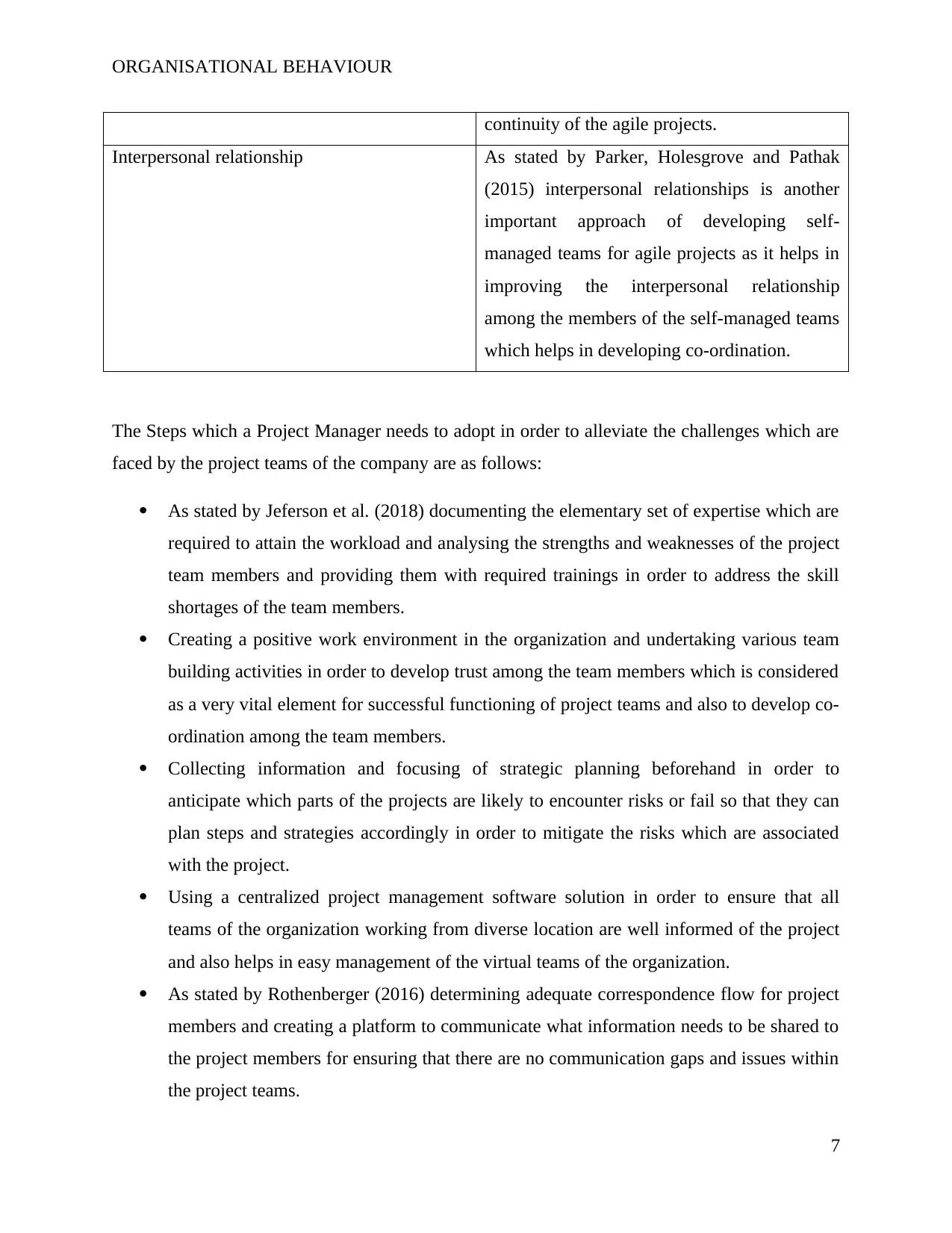
ORGANISATIONAL BEHAVIOUR
continuity of the agile projects.
Interpersonal relationship As stated by Parker, Holesgrove and Pathak
(2015) interpersonal relationships is another
important approach of developing self-
managed teams for agile projects as it helps in
improving the interpersonal relationship
among the members of the self-managed teams
which helps in developing co-ordination.
The Steps which a Project Manager needs to adopt in order to alleviate the challenges which are
faced by the project teams of the company are as follows:
As stated by Jeferson et al. (2018) documenting the elementary set of expertise which are
required to attain the workload and analysing the strengths and weaknesses of the project
team members and providing them with required trainings in order to address the skill
shortages of the team members.
Creating a positive work environment in the organization and undertaking various team
building activities in order to develop trust among the team members which is considered
as a very vital element for successful functioning of project teams and also to develop co-
ordination among the team members.
Collecting information and focusing of strategic planning beforehand in order to
anticipate which parts of the projects are likely to encounter risks or fail so that they can
plan steps and strategies accordingly in order to mitigate the risks which are associated
with the project.
Using a centralized project management software solution in order to ensure that all
teams of the organization working from diverse location are well informed of the project
and also helps in easy management of the virtual teams of the organization.
As stated by Rothenberger (2016) determining adequate correspondence flow for project
members and creating a platform to communicate what information needs to be shared to
the project members for ensuring that there are no communication gaps and issues within
the project teams.
7
continuity of the agile projects.
Interpersonal relationship As stated by Parker, Holesgrove and Pathak
(2015) interpersonal relationships is another
important approach of developing self-
managed teams for agile projects as it helps in
improving the interpersonal relationship
among the members of the self-managed teams
which helps in developing co-ordination.
The Steps which a Project Manager needs to adopt in order to alleviate the challenges which are
faced by the project teams of the company are as follows:
As stated by Jeferson et al. (2018) documenting the elementary set of expertise which are
required to attain the workload and analysing the strengths and weaknesses of the project
team members and providing them with required trainings in order to address the skill
shortages of the team members.
Creating a positive work environment in the organization and undertaking various team
building activities in order to develop trust among the team members which is considered
as a very vital element for successful functioning of project teams and also to develop co-
ordination among the team members.
Collecting information and focusing of strategic planning beforehand in order to
anticipate which parts of the projects are likely to encounter risks or fail so that they can
plan steps and strategies accordingly in order to mitigate the risks which are associated
with the project.
Using a centralized project management software solution in order to ensure that all
teams of the organization working from diverse location are well informed of the project
and also helps in easy management of the virtual teams of the organization.
As stated by Rothenberger (2016) determining adequate correspondence flow for project
members and creating a platform to communicate what information needs to be shared to
the project members for ensuring that there are no communication gaps and issues within
the project teams.
7
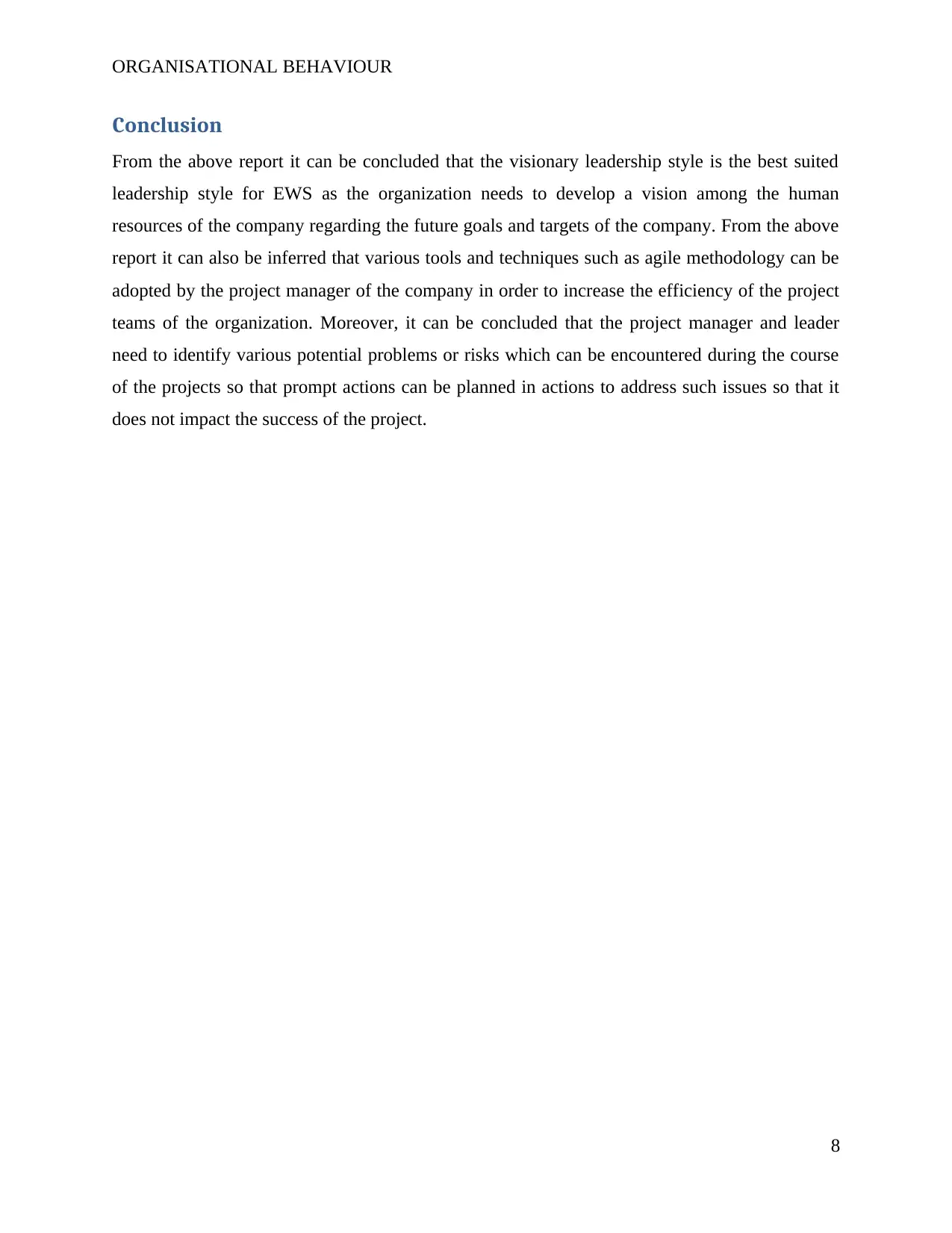
ORGANISATIONAL BEHAVIOUR
Conclusion
From the above report it can be concluded that the visionary leadership style is the best suited
leadership style for EWS as the organization needs to develop a vision among the human
resources of the company regarding the future goals and targets of the company. From the above
report it can also be inferred that various tools and techniques such as agile methodology can be
adopted by the project manager of the company in order to increase the efficiency of the project
teams of the organization. Moreover, it can be concluded that the project manager and leader
need to identify various potential problems or risks which can be encountered during the course
of the projects so that prompt actions can be planned in actions to address such issues so that it
does not impact the success of the project.
8
Conclusion
From the above report it can be concluded that the visionary leadership style is the best suited
leadership style for EWS as the organization needs to develop a vision among the human
resources of the company regarding the future goals and targets of the company. From the above
report it can also be inferred that various tools and techniques such as agile methodology can be
adopted by the project manager of the company in order to increase the efficiency of the project
teams of the organization. Moreover, it can be concluded that the project manager and leader
need to identify various potential problems or risks which can be encountered during the course
of the projects so that prompt actions can be planned in actions to address such issues so that it
does not impact the success of the project.
8
⊘ This is a preview!⊘
Do you want full access?
Subscribe today to unlock all pages.

Trusted by 1+ million students worldwide
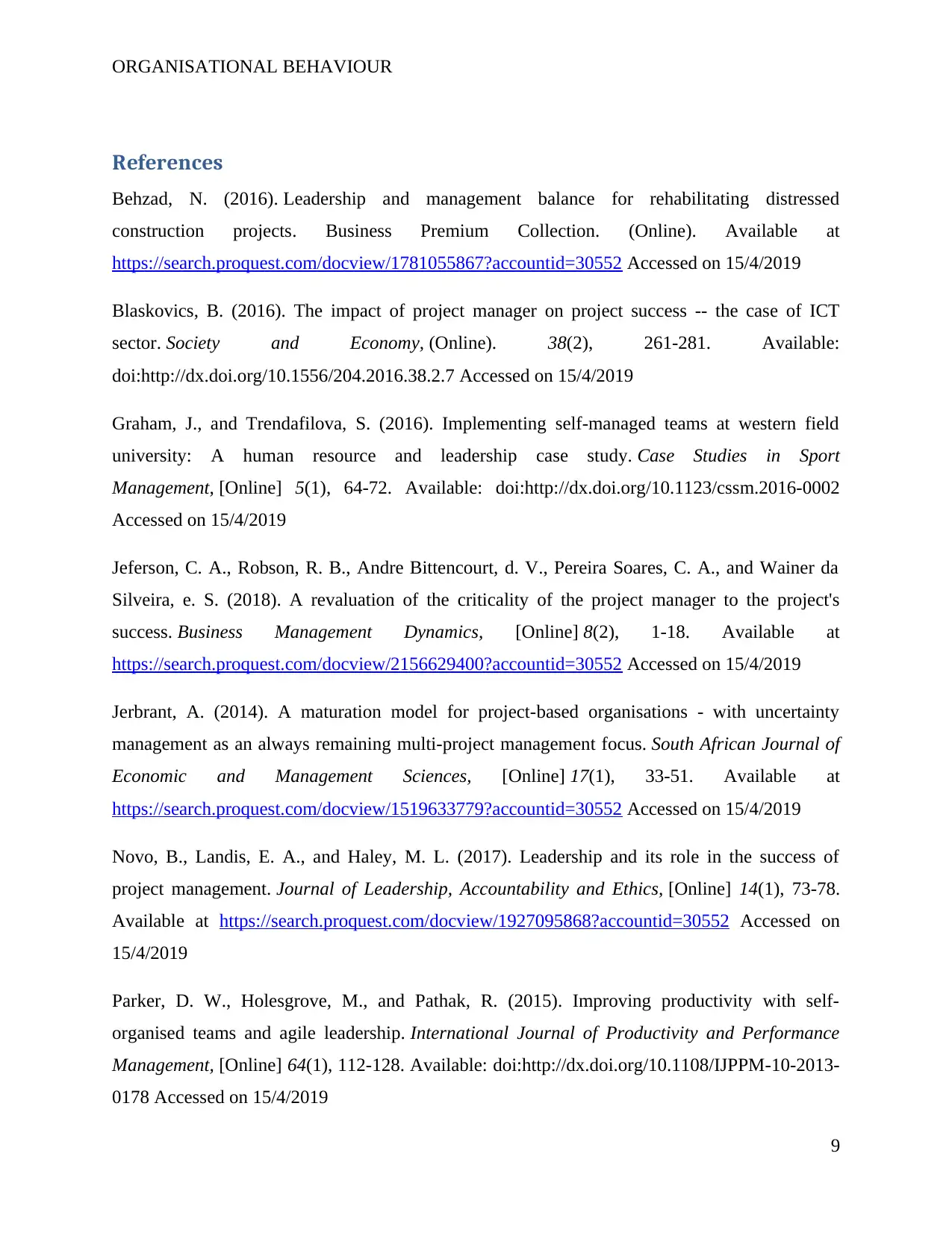
ORGANISATIONAL BEHAVIOUR
References
Behzad, N. (2016). Leadership and management balance for rehabilitating distressed
construction projects. Business Premium Collection. (Online). Available at
https://search.proquest.com/docview/1781055867?accountid=30552 Accessed on 15/4/2019
Blaskovics, B. (2016). The impact of project manager on project success -- the case of ICT
sector. Society and Economy, (Online). 38(2), 261-281. Available:
doi:http://dx.doi.org/10.1556/204.2016.38.2.7 Accessed on 15/4/2019
Graham, J., and Trendafilova, S. (2016). Implementing self-managed teams at western field
university: A human resource and leadership case study. Case Studies in Sport
Management, [Online] 5(1), 64-72. Available: doi:http://dx.doi.org/10.1123/cssm.2016-0002
Accessed on 15/4/2019
Jeferson, C. A., Robson, R. B., Andre Bittencourt, d. V., Pereira Soares, C. A., and Wainer da
Silveira, e. S. (2018). A revaluation of the criticality of the project manager to the project's
success. Business Management Dynamics, [Online] 8(2), 1-18. Available at
https://search.proquest.com/docview/2156629400?accountid=30552 Accessed on 15/4/2019
Jerbrant, A. (2014). A maturation model for project-based organisations - with uncertainty
management as an always remaining multi-project management focus. South African Journal of
Economic and Management Sciences, [Online] 17(1), 33-51. Available at
https://search.proquest.com/docview/1519633779?accountid=30552 Accessed on 15/4/2019
Novo, B., Landis, E. A., and Haley, M. L. (2017). Leadership and its role in the success of
project management. Journal of Leadership, Accountability and Ethics, [Online] 14(1), 73-78.
Available at https://search.proquest.com/docview/1927095868?accountid=30552 Accessed on
15/4/2019
Parker, D. W., Holesgrove, M., and Pathak, R. (2015). Improving productivity with self-
organised teams and agile leadership. International Journal of Productivity and Performance
Management, [Online] 64(1), 112-128. Available: doi:http://dx.doi.org/10.1108/IJPPM-10-2013-
0178 Accessed on 15/4/2019
9
References
Behzad, N. (2016). Leadership and management balance for rehabilitating distressed
construction projects. Business Premium Collection. (Online). Available at
https://search.proquest.com/docview/1781055867?accountid=30552 Accessed on 15/4/2019
Blaskovics, B. (2016). The impact of project manager on project success -- the case of ICT
sector. Society and Economy, (Online). 38(2), 261-281. Available:
doi:http://dx.doi.org/10.1556/204.2016.38.2.7 Accessed on 15/4/2019
Graham, J., and Trendafilova, S. (2016). Implementing self-managed teams at western field
university: A human resource and leadership case study. Case Studies in Sport
Management, [Online] 5(1), 64-72. Available: doi:http://dx.doi.org/10.1123/cssm.2016-0002
Accessed on 15/4/2019
Jeferson, C. A., Robson, R. B., Andre Bittencourt, d. V., Pereira Soares, C. A., and Wainer da
Silveira, e. S. (2018). A revaluation of the criticality of the project manager to the project's
success. Business Management Dynamics, [Online] 8(2), 1-18. Available at
https://search.proquest.com/docview/2156629400?accountid=30552 Accessed on 15/4/2019
Jerbrant, A. (2014). A maturation model for project-based organisations - with uncertainty
management as an always remaining multi-project management focus. South African Journal of
Economic and Management Sciences, [Online] 17(1), 33-51. Available at
https://search.proquest.com/docview/1519633779?accountid=30552 Accessed on 15/4/2019
Novo, B., Landis, E. A., and Haley, M. L. (2017). Leadership and its role in the success of
project management. Journal of Leadership, Accountability and Ethics, [Online] 14(1), 73-78.
Available at https://search.proquest.com/docview/1927095868?accountid=30552 Accessed on
15/4/2019
Parker, D. W., Holesgrove, M., and Pathak, R. (2015). Improving productivity with self-
organised teams and agile leadership. International Journal of Productivity and Performance
Management, [Online] 64(1), 112-128. Available: doi:http://dx.doi.org/10.1108/IJPPM-10-2013-
0178 Accessed on 15/4/2019
9
Paraphrase This Document
Need a fresh take? Get an instant paraphrase of this document with our AI Paraphraser
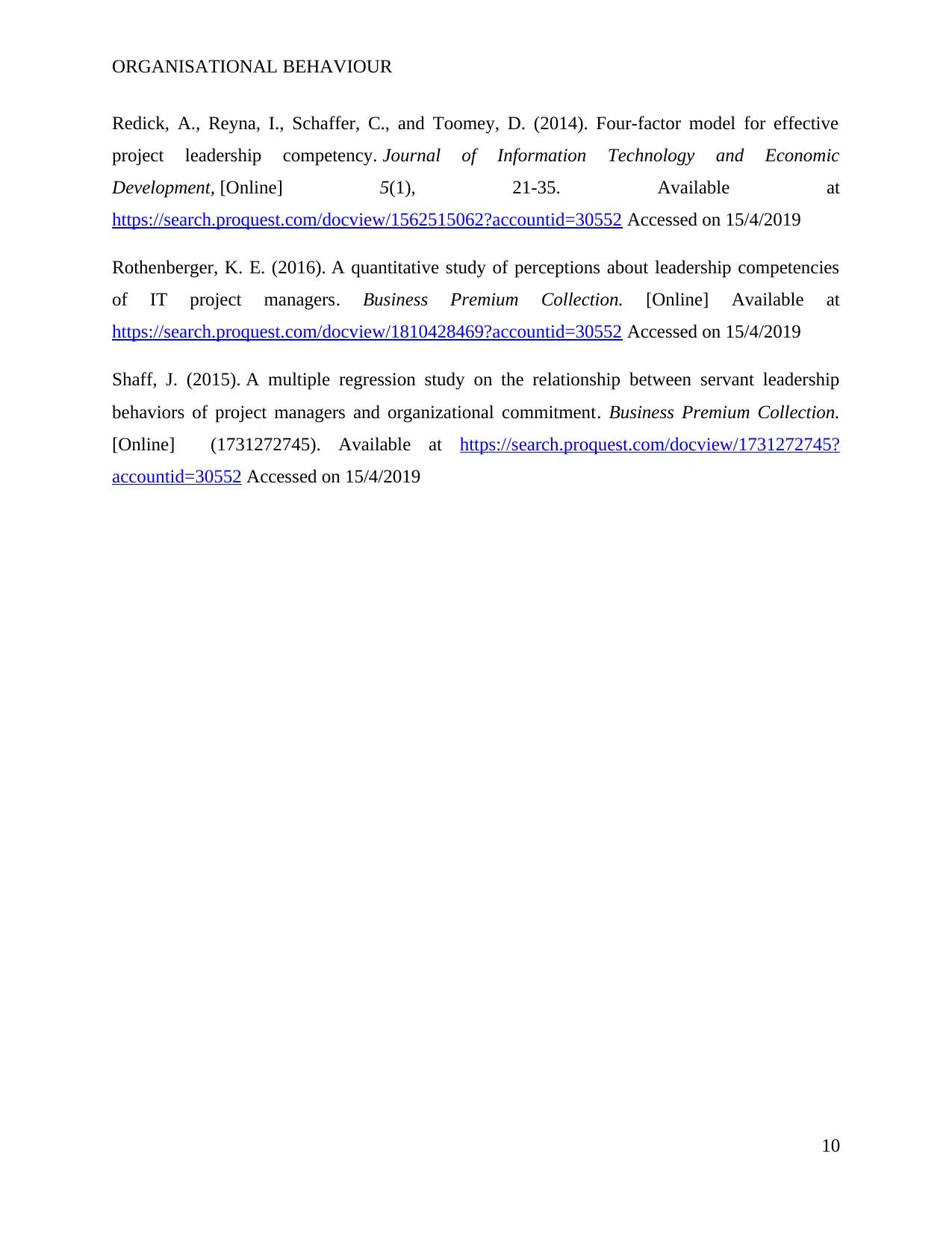
ORGANISATIONAL BEHAVIOUR
Redick, A., Reyna, I., Schaffer, C., and Toomey, D. (2014). Four-factor model for effective
project leadership competency. Journal of Information Technology and Economic
Development, [Online] 5(1), 21-35. Available at
https://search.proquest.com/docview/1562515062?accountid=30552 Accessed on 15/4/2019
Rothenberger, K. E. (2016). A quantitative study of perceptions about leadership competencies
of IT project managers. Business Premium Collection. [Online] Available at
https://search.proquest.com/docview/1810428469?accountid=30552 Accessed on 15/4/2019
Shaff, J. (2015). A multiple regression study on the relationship between servant leadership
behaviors of project managers and organizational commitment. Business Premium Collection.
[Online] (1731272745). Available at https://search.proquest.com/docview/1731272745?
accountid=30552 Accessed on 15/4/2019
10
Redick, A., Reyna, I., Schaffer, C., and Toomey, D. (2014). Four-factor model for effective
project leadership competency. Journal of Information Technology and Economic
Development, [Online] 5(1), 21-35. Available at
https://search.proquest.com/docview/1562515062?accountid=30552 Accessed on 15/4/2019
Rothenberger, K. E. (2016). A quantitative study of perceptions about leadership competencies
of IT project managers. Business Premium Collection. [Online] Available at
https://search.proquest.com/docview/1810428469?accountid=30552 Accessed on 15/4/2019
Shaff, J. (2015). A multiple regression study on the relationship between servant leadership
behaviors of project managers and organizational commitment. Business Premium Collection.
[Online] (1731272745). Available at https://search.proquest.com/docview/1731272745?
accountid=30552 Accessed on 15/4/2019
10
1 out of 11
Related Documents
Your All-in-One AI-Powered Toolkit for Academic Success.
+13062052269
info@desklib.com
Available 24*7 on WhatsApp / Email
![[object Object]](/_next/static/media/star-bottom.7253800d.svg)
Unlock your academic potential
Copyright © 2020–2025 A2Z Services. All Rights Reserved. Developed and managed by ZUCOL.



